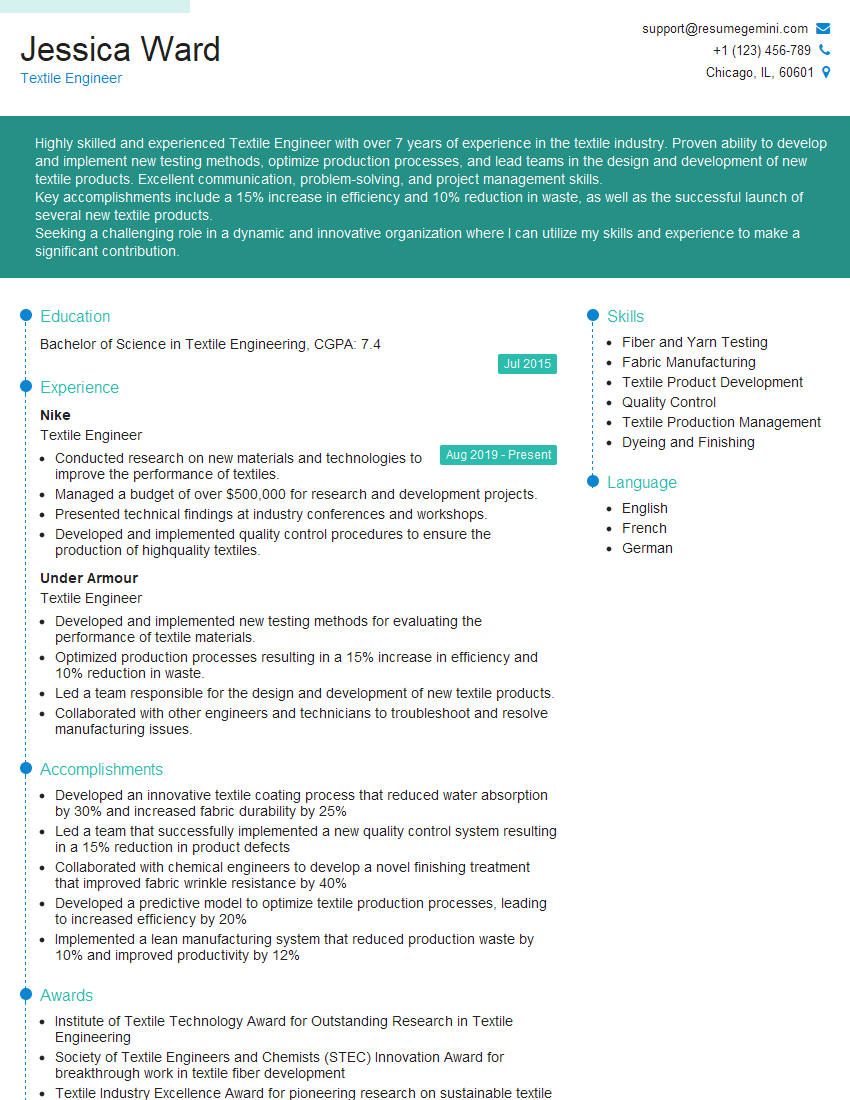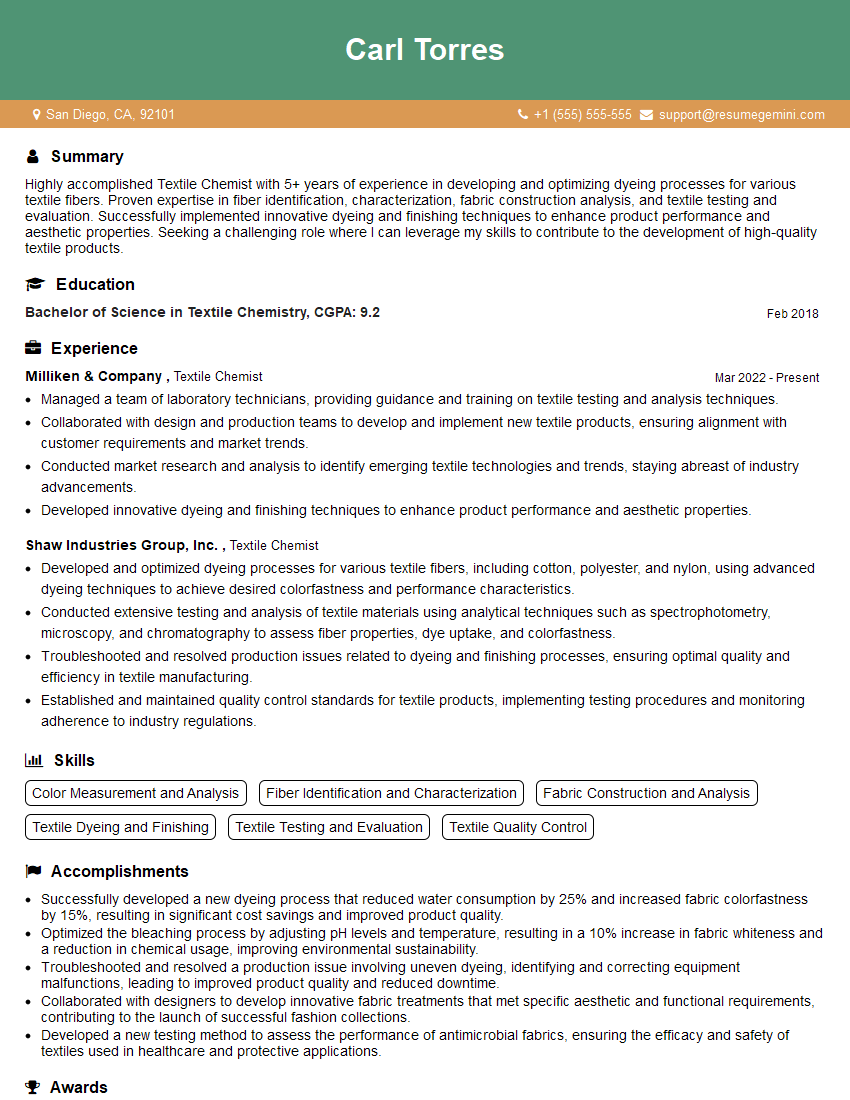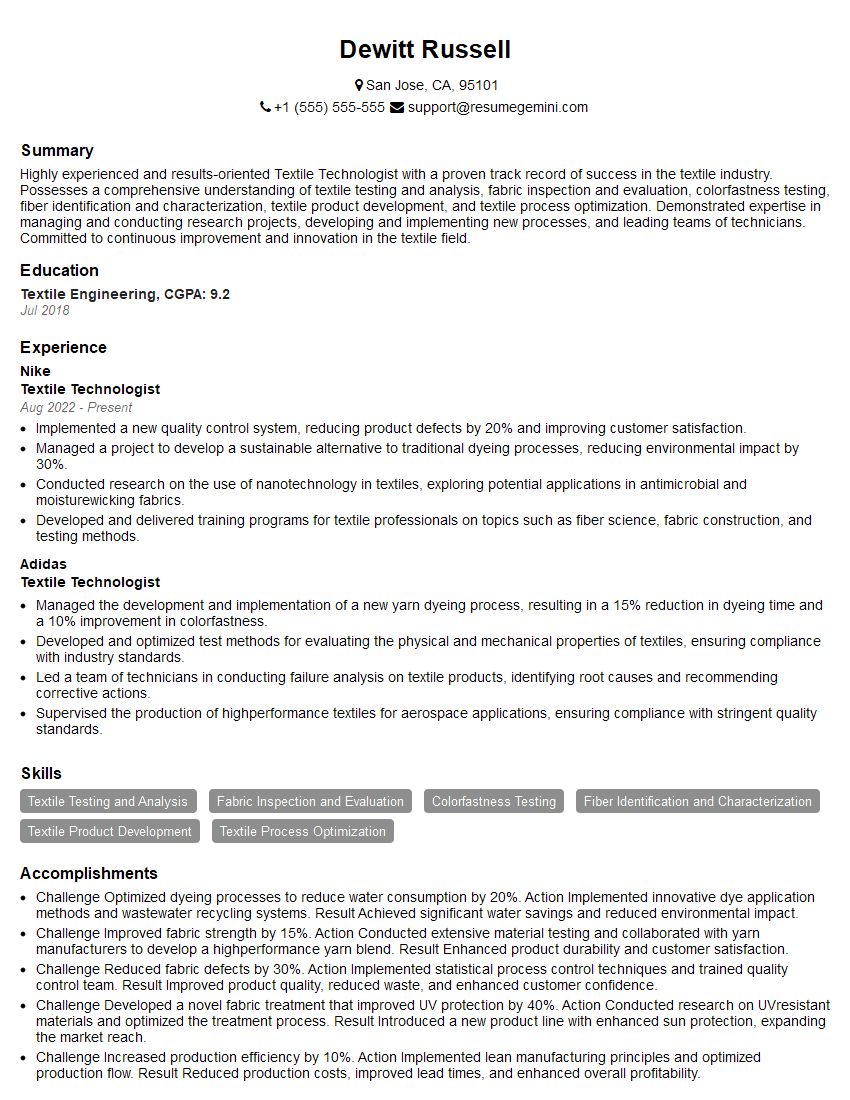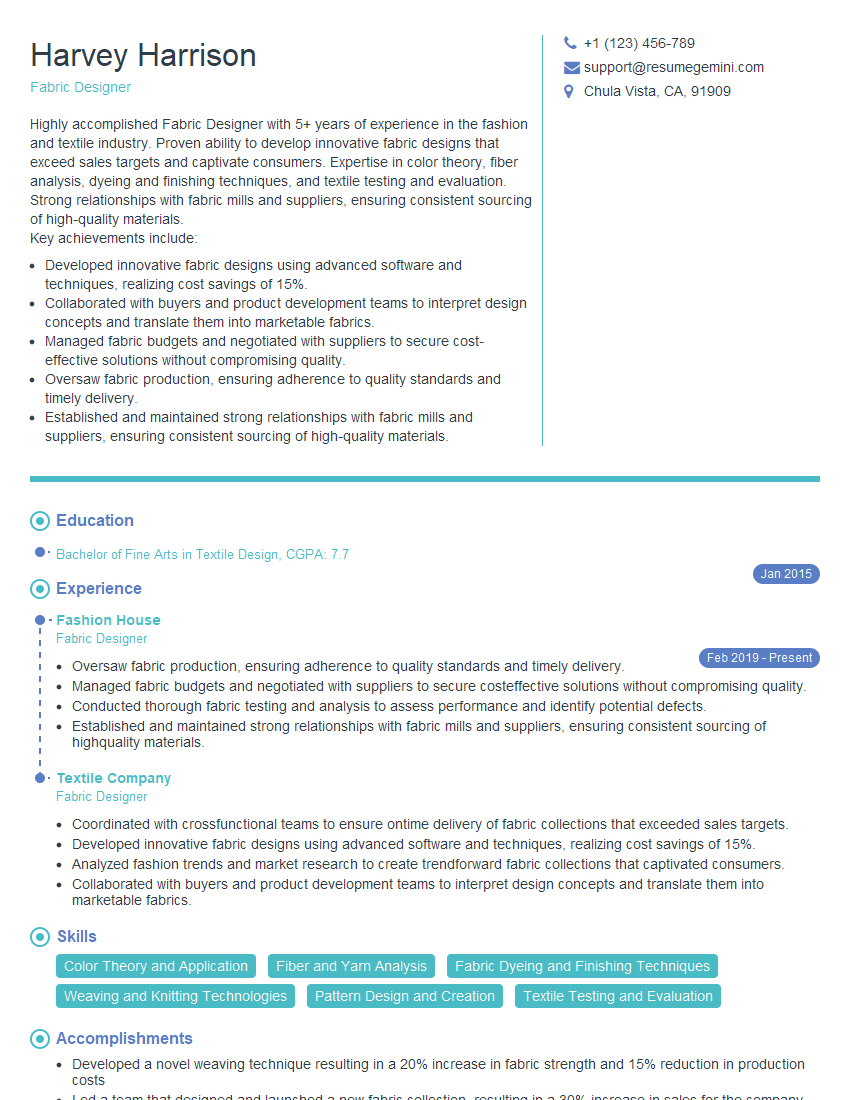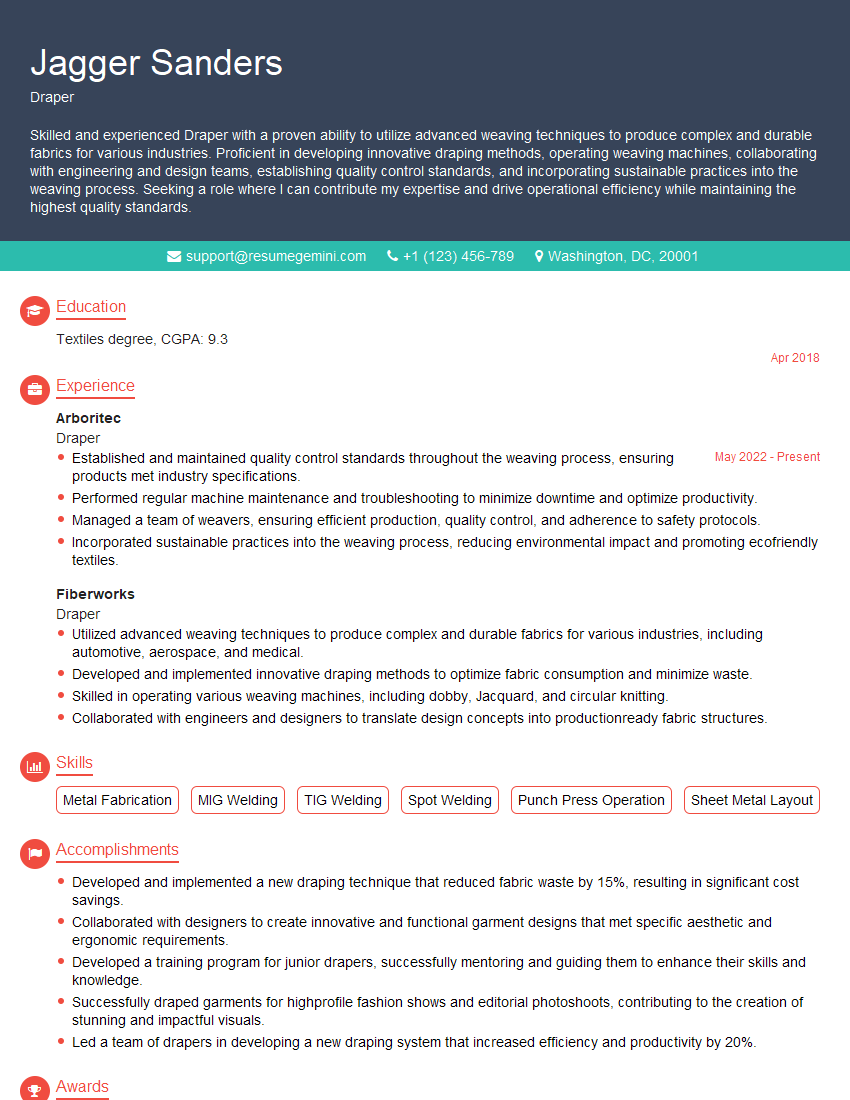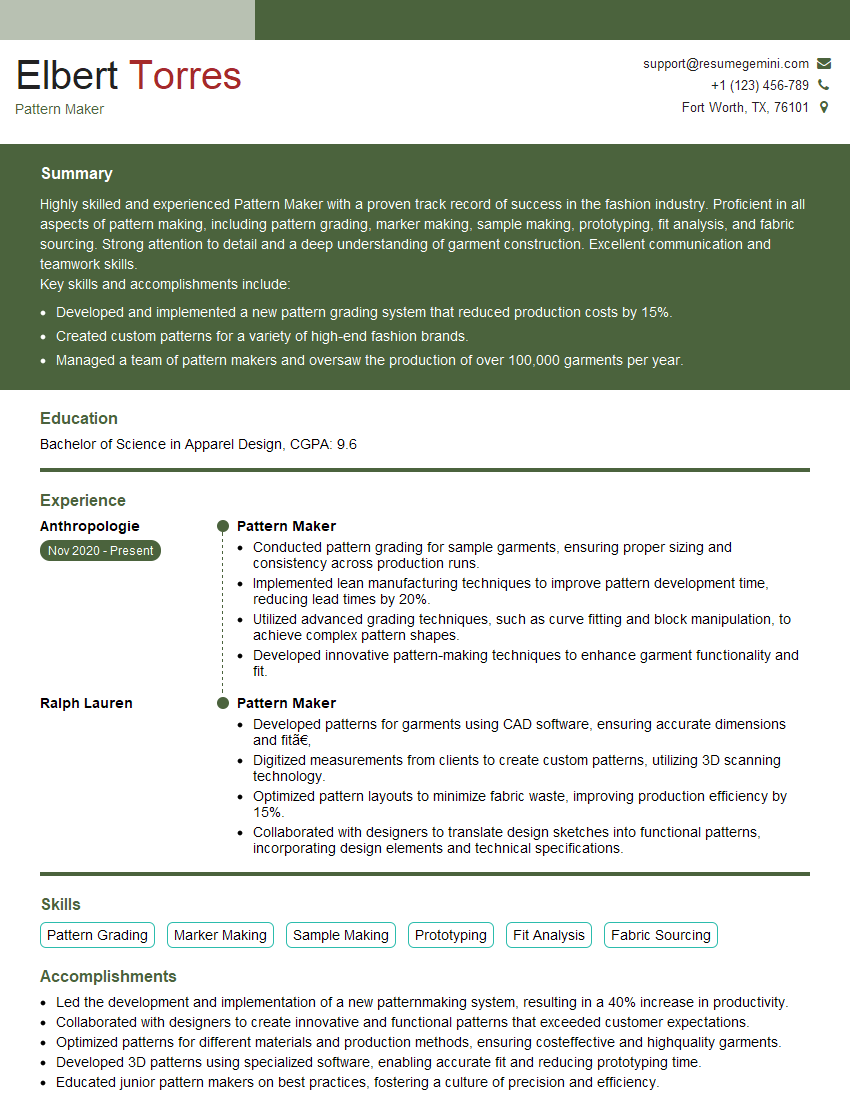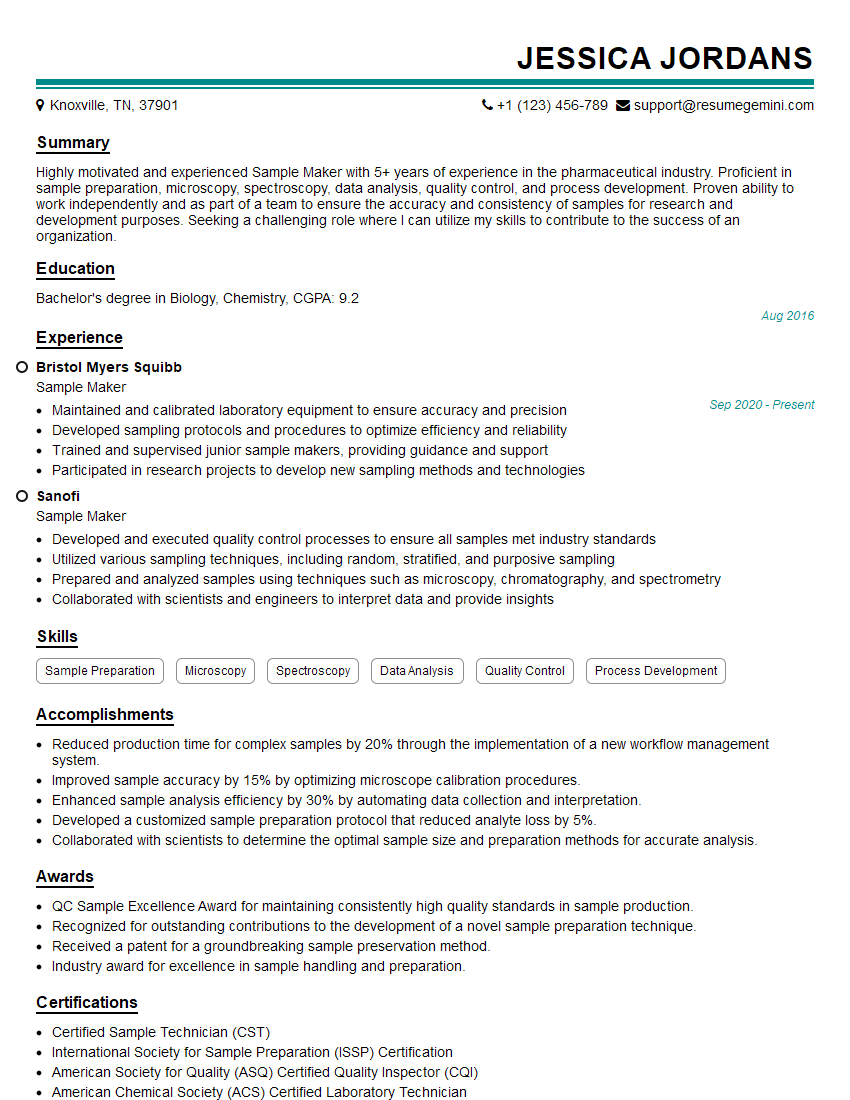Every successful interview starts with knowing what to expect. In this blog, we’ll take you through the top Experience in working with a variety of fabrics and materials interview questions, breaking them down with expert tips to help you deliver impactful answers. Step into your next interview fully prepared and ready to succeed.
Questions Asked in Experience in working with a variety of fabrics and materials Interview
Q 1. Describe your experience working with various types of fabrics, such as cotton, silk, wool, and synthetics.
My experience spans a wide range of fabrics, from natural fibers like cotton, silk, and wool to various synthetics such as polyester, nylon, and rayon. Working with cotton, I’ve found its breathability and absorbency make it ideal for summer clothing and everyday wear. However, its tendency to wrinkle requires careful consideration in garment design. Silk, with its luxurious drape and sheen, presents unique challenges in terms of delicate handling and specialized cleaning. Wool, known for its warmth and insulating properties, demands an understanding of its felting potential during processing and cleaning. Synthetics, on the other hand, offer a diverse range of properties – from the durability of polyester to the elasticity of spandex. I’ve learned to adapt my techniques and choose appropriate finishing processes based on the specific characteristics of each fabric type. For instance, I’ve successfully created both tailored suits from high-quality wool and moisture-wicking athletic wear using performance synthetics. This diverse experience allows me to effectively select and work with any material, understanding its strengths and weaknesses.
Q 2. Explain the differences in drape and texture between natural and synthetic fabrics.
Natural and synthetic fabrics exhibit significant differences in drape and texture. Natural fibers like silk and wool possess a unique drape often described as having ‘body’ or ‘hand’. Silk drapes beautifully, falling smoothly in elegant folds, while wool can have a fuller, more substantial drape depending on its weight and processing. These drapes are a result of the natural fiber structure. In contrast, synthetic fabrics like polyester often possess a stiffer, less fluid drape. They may feel less luxurious to the touch and tend to resist creasing more readily than natural fibers. The texture also differs significantly. Natural fibers such as cotton, depending on the weave and finish, can range from smooth and crisp to soft and fluffy. Wool possesses a characteristic ‘fuzziness’ often described as its natural ‘loft’. Synthetic fibers, on the other hand, can feel smooth and slippery (like nylon) or rough and textured (like some polyester blends), with textures largely dependent on the manufacturing process and any added finishes. Understanding these differences is crucial for appropriate garment selection and design. For instance, a flowing silk gown requires a fabric with exceptional drape, while a durable workwear uniform benefits from the strength and crease resistance of a synthetic blend.
Q 3. How do you determine the appropriate fabric for a specific garment or project?
Choosing the right fabric for a garment involves a careful consideration of several factors: the intended use, the desired aesthetic, and the wearer’s needs. For example, a summer dress needs a breathable, lightweight fabric like cotton or linen. A winter coat requires a warm, water-resistant fabric like wool or a synthetic blend with similar properties. The desired aesthetic influences the choice as well – a formal evening gown might call for luxurious silk or velvet, while casual wear might utilize denim or jersey. I consider the end-use: will the garment be machine-washed or dry-cleaned? Will it need to withstand frequent wear and tear? The wearer’s needs are also vital; a person with sensitive skin might need a hypoallergenic fabric like organic cotton. I often create a ‘fabric specification’ outlining all necessary properties. This specification guides the selection process, ensuring the final product meets all requirements. This systematic approach guarantees quality and suitability for the intended purpose.
Q 4. Describe your experience with fabric testing and quality control procedures.
My experience with fabric testing and quality control is extensive. I’m proficient in various testing methods, including tensile strength tests to assess durability, abrasion resistance tests to evaluate wear and tear, and colorfastness tests to ensure color retention after washing. I use these tests throughout the production process, from initial fabric selection to the final inspection of completed garments. I am also familiar with assessing fabric shrinkage and identifying inconsistencies in weave or knit structure. Quality control for me isn’t just about meeting minimum standards; it’s about exceeding expectations. I meticulously inspect each roll of fabric for defects, looking for flaws such as holes, snags, and irregularities in the weave. This thorough approach ensures the final product is of consistently high quality and meets the desired specifications. I’ve worked with different standards, ensuring compliance with industry regulations and client requirements. This quality-focused approach has been instrumental in building trust with clients and maintaining a high reputation for my work.
Q 5. What are some common fabric defects and how do you identify and address them?
Common fabric defects include holes, snags, slubs (thickened areas in yarn), broken ends (loose yarn ends), and misprints (in printed fabrics). Identifying these defects requires a keen eye and a thorough understanding of fabric construction. I use a combination of visual inspection, often under magnification, and tactile examination to identify defects. Addressing these defects depends on the severity and location. Minor defects might be acceptable depending on the garment type and location, such as a small slub in a less prominent area. Major defects, however, such as large holes or significant inconsistencies, usually require rejecting the fabric or making adjustments in the garment design to avoid the affected areas. I’ve developed a system for documenting and tracking defects, which has been very helpful in identifying trends and preventing future issues. This proactive approach minimizes waste and maximizes efficiency.
Q 6. How familiar are you with different weaving and knitting techniques?
My familiarity with weaving and knitting techniques is comprehensive. I understand the differences between various weaves, such as plain weave, twill weave, satin weave, and their impact on fabric properties like drape, texture, and durability. Similarly, I’m well-versed in different knitting structures, including jersey, rib, and purl, and how these structures affect the fabric’s stretch, recovery, and overall feel. I’ve worked with various yarns and threads, understanding their properties and how they influence the final fabric. I’ve also experienced working with different gauges of knitting and weaving, understanding how that impacts the final weight and texture of the fabric. This knowledge helps me select appropriate fabrics for different projects, predict their behavior during processing, and design patterns that complement the fabric’s inherent structure.
Q 7. Explain your experience with dyeing and finishing processes.
My experience with dyeing and finishing processes is significant. I’m familiar with various dyeing techniques, including reactive dyeing, vat dyeing, and disperse dyeing, and understand how these techniques affect color depth, fastness, and the overall hand feel of the fabric. Finishing processes, such as mercerization, calendaring, and coating, are also part of my expertise. I know how these processes enhance fabric properties such as luster, smoothness, and wrinkle resistance. I’ve worked extensively with different finishing agents and understand their impact on the environmental profile of the manufacturing process. Choosing appropriate dyeing and finishing methods is crucial for achieving the desired aesthetic and functional properties. For instance, mercerized cotton possesses a higher luster and improved strength compared to untreated cotton. I always keep in mind the sustainability aspect of the processes, opting for environmentally friendly options whenever possible. My goal is always to create high-quality products with minimal impact on the environment.
Q 8. Describe your understanding of fabric shrinkage and how to prevent it.
Fabric shrinkage is the reduction in size of a textile after washing or exposure to moisture and heat. It’s primarily caused by the relaxation of fibers, which can be natural (like wool or cotton) or synthetic (like polyester). Preventing shrinkage involves understanding the fiber content and pre-treating the fabric.
Pre-washing: Always pre-wash fabrics, especially natural fibers like cotton and linen, before cutting and sewing. This allows the fabric to shrink before construction, preventing a final garment from shrinking after the effort of creation.
Choosing the right fabric: Opt for fabrics labeled as ‘pre-shrunk’ or ‘sanforized’. Sanforizing is a mechanical process that reduces shrinkage significantly.
Gentle washing: Wash delicate fabrics in cold water and use a gentle cycle. Avoid harsh detergents or bleach.
Proper drying: Air drying is the best method for most fabrics. If machine drying, use a low heat setting and remove garments promptly to prevent wrinkles and further shrinkage.
Testing a swatch: Before starting a project, always wash and dry a small swatch of the fabric to check for shrinkage. This allows for accurate measurements and prevents costly mistakes.
For example, I once worked on a high-end wool suit. Pre-washing the wool significantly reduced the risk of the finished suit shrinking after the client had worn it, preserving both the quality of the garment and my professional reputation.
Q 9. How do you handle different fabric weights and their impact on garment construction?
Fabric weight significantly influences garment construction. Heavier fabrics like denim or wool require stronger needles, more robust stitching, and potentially different construction techniques compared to lightweight fabrics such as silk or chiffon.
Needle Selection: Heavier fabrics necessitate thicker needles to prevent breakage. Conversely, thinner needles are crucial for lightweight materials to avoid piercing and damage.
Seam Allowance: Wider seam allowances may be necessary for heavier fabrics to prevent distortion and ensure durability. Lightweight fabrics typically require narrower seam allowances.
Stitch Type: Stronger stitch types, such as a double-straight stitch or a zig-zag stitch for added reinforcement, are ideal for heavier fabrics. Lightweight fabrics often benefit from finer, less bulky stitches.
Interfacing: Heavier fabrics might require interfacing to provide support and structure. Lightweight materials, however, may not require interfacing, and using it could make the garment too stiff.
Pattern Adjustments: Patterns may require adjustments for heavier fabrics to account for their drape and weight. A heavier fabric might need a larger seam allowance, or alterations to the pattern for better movement.
For instance, designing a structured jacket in heavy tweed requires different techniques than creating a flowing summer dress in lightweight cotton voile. The heavier tweed needs more robust stitching and potentially additional reinforcements, while the voile requires a gentler touch to maintain the fabric’s drape and softness.
Q 10. What software or tools are you proficient in using for fabric design or analysis?
I’m proficient in various software for fabric design and analysis. This includes Adobe Illustrator for creating digital prints and patterns, Photoshop for manipulating images and color correction, and CLO 3D for 3D garment modeling and simulation.
Adobe Illustrator: I utilize Illustrator’s vector-based tools to create intricate patterns, repeat designs, and generate technical drawings for garment construction. For example, I have designed custom floral prints for several clothing lines.
Adobe Photoshop: Photoshop allows me to adjust color palettes, create textures, and manipulate images for seamless integration into fabric designs and presentations to clients.
CLO 3D: CLO 3D is invaluable for creating 3D virtual prototypes, enabling me to test garment fit, drape, and construction details before actual production. This significantly reduces potential errors and saves time and resources.
My expertise in these tools allows me to iterate designs quickly, explore various options, and ensure the final product meets the client’s vision and technical specifications.
Q 11. Explain your experience with pattern making and grading.
Pattern making and grading are fundamental skills in garment construction. Pattern making involves creating the initial pattern pieces based on measurements and design specifications. Grading adapts those patterns to different sizes.
Pattern Making: I’m skilled in drafting patterns from scratch using both flat pattern techniques and draping methods. Draping allows for more complex designs and better fabric drape simulation, while flat pattern techniques are more precise for simple silhouettes.
Grading: Grading involves systematically increasing or decreasing the pattern pieces to create a range of sizes. This process requires precise calculations and attention to detail to maintain the integrity of the design across all sizes. I utilize both manual grading techniques and computer-aided design (CAD) software for efficient and accurate grading.
I’ve successfully designed and graded patterns for numerous garments, from simple t-shirts to intricate evening gowns, ensuring a consistent fit across all size ranges. For example, I recently developed a pattern for a children’s clothing line that needed to scale accurately across a wide range of sizes, requiring precise grading to maintain proportions.
Q 12. How do you manage fabric sourcing and ensure timely delivery?
Fabric sourcing and timely delivery are critical for project success. My approach involves establishing strong relationships with reliable suppliers, careful selection of materials, and meticulous order management.
Supplier Relationships: I maintain relationships with multiple fabric suppliers to ensure options and mitigate potential supply chain disruptions. I prioritize suppliers with a proven track record of quality and reliability.
Material Selection: I carefully select fabrics based on the project requirements, considering factors like fiber content, weight, drape, and color. I thoroughly review samples before placing large orders.
Order Management: I use project management tools and spreadsheets to track orders, manage deadlines, and communicate effectively with suppliers. This ensures timely delivery and minimizes potential delays.
Quality Control: Upon receiving the fabric, I conduct thorough quality checks to ensure it meets the specifications outlined in the order and is free of defects.
In one instance, a critical fabric order was delayed due to unforeseen circumstances at the supplier’s factory. Through proactive communication and alternative sourcing strategies, I was able to secure a replacement fabric with minimal impact on the project timeline, demonstrating my ability to manage unexpected challenges.
Q 13. Describe your experience working with different types of sewing machines.
My experience encompasses a variety of sewing machines, from basic domestic machines to industrial-grade equipment. This includes machines for straight stitching, overlocking (serging), embroidery, and quilting.
Domestic Machines: I’m proficient in using domestic sewing machines for various tasks, including garment construction, alterations, and repairs. Understanding their limitations and capabilities is essential for efficiency.
Industrial Machines: My experience with industrial sewing machines allows me to execute large-scale projects with high precision and speed. This is especially important for high-volume production.
Specialized Machines: I’ve worked with specialized machines, such as overlockers for neat seam finishes and coverstitch machines for professional-looking hems. The correct machine for the job is paramount for a quality product.
My ability to adapt to different sewing machines ensures that I can efficiently produce high-quality garments regardless of the equipment available. For example, switching between a domestic machine for intricate detail work and an industrial machine for bulk stitching enhances efficiency without compromising quality.
Q 14. How do you troubleshoot problems related to fabric cutting, sewing, or construction?
Troubleshooting is an integral part of garment construction. My approach involves systematically identifying the problem, testing potential solutions, and implementing corrective actions.
Fabric Cutting Issues: Problems with fabric cutting, such as inaccurate measurements or uneven cuts, are often addressed by double-checking patterns, ensuring sharp cutting tools, and using appropriate cutting surfaces. Using a rotary cutter and self-healing cutting mat can greatly improve accuracy.
Sewing Problems: Sewing issues, such as skipped stitches or broken needles, are usually resolved by adjusting tension, changing needles, or checking the bobbin. Proper machine maintenance is key.
Construction Challenges: Construction problems, such as ill-fitting garments or uneven seams, often require careful analysis of the pattern, adjustments to the sewing techniques, or a re-evaluation of the fabric choice.
Systematic Approach: I approach troubleshooting systematically, starting with the simplest solutions and progressing to more complex ones. I meticulously document the problem, the steps taken, and the outcome to learn from past experiences and refine my problem-solving skills.
Recently, I encountered a problem with puckering in a silk garment. Through a process of elimination, I identified the cause as improper tension settings on the sewing machine and successfully resolved the issue by adjusting the tension and using a smaller stitch length.
Q 15. How familiar are you with various textile finishing treatments?
My familiarity with textile finishing treatments is extensive. I’ve worked with a wide range, from basic processes like bleaching and dyeing to more specialized treatments aimed at improving performance characteristics. These include:
- Dyeing: I’m proficient in various dyeing methods, including reactive, vat, disperse, and acid dyeing, understanding how fiber type and dye chemistry influence the final color and its fastness.
- Finishing: This encompasses treatments like calendaring (to improve smoothness and luster), mercerization (to enhance strength and luster in cotton), and softening (to improve hand feel). I understand the implications of each treatment on the fabric’s drape, durability, and overall quality.
- Water Repellent Treatments: I have experience with durable water repellent (DWR) finishes, understanding the trade-offs between water resistance and breathability, crucial for outerwear fabrics.
- Flame Retardant Treatments: I’m familiar with various flame-retardant treatments, essential for meeting safety standards in upholstery and certain apparel applications. These often involve chemical application or the use of inherently flame-resistant fibers.
- Antimicrobial Treatments: These are increasingly important, especially in healthcare and sportswear. I’ve worked with fabrics incorporating antimicrobial agents to inhibit bacterial growth and odor.
My experience enables me to select the optimal finishing treatment for any given fabric and its intended use, considering both aesthetic and performance requirements.
Career Expert Tips:
- Ace those interviews! Prepare effectively by reviewing the Top 50 Most Common Interview Questions on ResumeGemini.
- Navigate your job search with confidence! Explore a wide range of Career Tips on ResumeGemini. Learn about common challenges and recommendations to overcome them.
- Craft the perfect resume! Master the Art of Resume Writing with ResumeGemini’s guide. Showcase your unique qualifications and achievements effectively.
- Don’t miss out on holiday savings! Build your dream resume with ResumeGemini’s ATS optimized templates.
Q 16. Explain your experience working with sustainable or eco-friendly fabrics.
Sustainability is a core value in my work. I have significant experience with eco-friendly fabrics, focusing on both fiber sourcing and processing methods. This includes:
- Organic Cotton: I’ve worked extensively with organic cotton, understanding its benefits regarding reduced pesticide use and improved soil health. However, I’m also aware of the challenges in terms of yield and cost compared to conventionally grown cotton.
- Recycled Fabrics: I’ve used recycled polyester, nylon, and other fibers, contributing to diverting textile waste from landfills. I understand the challenges related to fiber quality and the potential need for blending to achieve desired performance characteristics.
- Tencel (Lyocell): This sustainably sourced fiber, derived from wood pulp, offers a great alternative to conventional cotton, with a lower environmental impact. I’ve used it in various applications, appreciating its soft hand feel and drape.
- Hemp and Linen: These natural fibers require less water and pesticides than cotton, offering a sustainable choice. However, understanding their unique properties, like wrinkling, is crucial for successful product development.
- Low-Impact Dyeing Techniques: I actively seek out dyeing processes that minimize water and energy consumption and reduce the use of harmful chemicals. This includes exploring low-impact dyes and responsible wastewater management techniques.
Beyond the choice of materials, I also prioritize minimizing waste throughout the entire process, from fabric selection to production and finishing. This ensures environmentally responsible practices are followed across the board.
Q 17. How do you manage fabric inventory and minimize waste?
Efficient fabric inventory management and waste minimization are critical for cost-effectiveness and sustainability. My approach involves:
- Precise Forecasting: Accurate demand forecasting based on sales data and market trends to prevent overstocking of fabrics.
- Just-in-Time Inventory: Working closely with suppliers to ensure fabrics are received only as needed, minimizing storage costs and reducing the risk of obsolescence.
- Inventory Tracking System: Utilizing a robust system to track fabric quantities, location, and usage, allowing for real-time monitoring and efficient allocation.
- Careful Planning & Cutting Techniques: Implementing efficient cutting plans to minimize fabric waste during garment production, often using computer-aided design (CAD) systems.
- Fabric Remnant Utilization: Identifying ways to utilize fabric remnants for smaller projects, samples, or patchwork, preventing unnecessary disposal.
- Donation or Recycling Programs: Exploring partnerships with organizations that accept textile waste for recycling or reuse when remnants cannot be utilized otherwise.
By implementing these strategies, I ensure that fabric inventory is well-managed and waste is minimized, contributing to both economic and environmental sustainability.
Q 18. Describe your experience with fabric printing techniques.
My experience in fabric printing is extensive, encompassing various techniques and their applications. I have hands-on experience with different printing methods such as screen printing, digital printing, and rotary printing.
- Screen Printing: I’m adept at setting up and operating screen printing presses, creating stencils, and applying inks to achieve desired designs. Understanding mesh counts, ink viscosity, and curing processes is critical for quality and consistency.
- Digital Printing: I have experience with direct-to-garment (DTG) and inkjet printing techniques. This allows for highly detailed and customizable designs with exceptional color accuracy. I understand file preparation and printer calibration to ensure optimal print quality.
- Rotary Printing: I’m familiar with this technique used for large-scale production, particularly for designs that repeat. It’s an efficient method when high volumes are required. Knowledge of the intricacies of cylinder preparation and ink application is essential.
Beyond the technical aspects, I possess a strong understanding of color theory, ink selection, and fabric suitability for different printing techniques. This allows me to choose the optimal printing method based on design complexity, required quantity, and budget constraints. I also consider the environmental impact of each technique when making my decisions.
Q 19. How do you stay updated on industry trends and new fabric technologies?
Staying updated on industry trends and new fabric technologies is crucial in my field. I utilize a multi-faceted approach:
- Industry Publications & Journals: I regularly read trade magazines and journals such as Textile World and Textile View to keep abreast of the latest developments in materials and technologies.
- Trade Shows and Conferences: Attending industry events like Premiere Vision and Texworld provides opportunities to network with experts, see new fabric collections, and learn about emerging technologies firsthand.
- Online Resources & Websites: I actively monitor relevant websites and blogs, attending online webinars and exploring resources offered by fabric manufacturers and research institutions.
- Networking with Industry Professionals: Maintaining a strong network of contacts within the textile industry helps me stay informed about advancements through discussions, collaborations, and knowledge sharing.
- Research & Development: I actively engage in research and development initiatives, exploring the properties and applications of novel fabrics, such as bio-based materials and advanced performance fabrics.
This proactive approach ensures that my knowledge base is current and that I can incorporate the latest innovations into my work.
Q 20. Explain your experience with different fabric printing techniques (e.g., screen printing, digital printing).
As mentioned previously, I have extensive experience with various fabric printing techniques, particularly screen and digital printing. Let’s delve deeper into their differences:
- Screen Printing: This is a time-tested technique ideal for vibrant, bold designs on a variety of fabrics. It’s relatively inexpensive for small-to-medium runs and allows for thick ink applications, resulting in a tactile print. However, it’s less efficient for highly detailed or complex designs and requires significant setup time for each color.
- Digital Printing: This method uses inkjet technology for precise and intricate designs, ideal for photorealistic images and intricate details. It’s highly efficient for short runs and allows for on-demand printing, reducing waste. However, it can be more expensive than screen printing for large-scale productions and the print may not be as durable as screen printing depending on the inks and pre-treatment used.
The choice between these techniques depends on factors such as the design complexity, the quantity needed, the budget, and the desired final effect. I often combine techniques, such as using screen printing for base colors and digital printing for intricate details.
Q 21. Describe a time you had to solve a challenging problem related to fabric selection or construction.
In a recent project, we needed a fabric for a high-performance sportswear line that would be both lightweight, breathable, and highly water-resistant. Finding a single fabric meeting all these requirements proved challenging. Initially, we considered a standard nylon ripstop, but its breathability was insufficient. We then explored various membrane-based fabrics, but their weight and stiffness were unsuitable.
To solve this, I employed a systematic approach:
- Thorough Research: I researched various fabric blends and construction techniques, focusing on materials like Gore-Tex Infinium and similar lightweight membrane technologies.
- Supplier Consultation: I collaborated closely with fabric suppliers, providing detailed specifications and discussing potential options. This included exploring the possibility of custom fabric development.
- Prototyping and Testing: We produced several prototypes using different fabric samples and conducted rigorous testing, including assessing breathability, water resistance, and durability.
- Fabric Blending: Ultimately, the solution involved a custom blend of a lightweight nylon base with a strategically applied DWR treatment and a thin, breathable membrane. This resulted in a fabric meeting all required specifications.
This experience underscored the importance of collaboration, meticulous testing, and a willingness to explore unconventional solutions when facing challenging fabric selection dilemmas.
Q 22. How do you maintain accurate records of fabric properties and specifications?
Maintaining accurate fabric records is crucial for consistency and traceability throughout the production process. I utilize a digital database system that includes detailed specifications for each fabric, including:
- Fiber Content: Percentage of each fiber (e.g., 60% cotton, 40% polyester).
- Yarn Count: Describes the fineness and density of the yarn (e.g., 100/2).
- Weave Structure: Indicates how yarns are interlaced (e.g., plain weave, twill weave, satin weave).
- Weight/GSM: Grams per square meter, indicating fabric weight.
- Width: The width of the fabric roll.
- Colorway: Specific color code and shade.
- Supplier Information: Source of the fabric and contact details.
- Test Results: Data from tests like tensile strength, abrasion resistance, and colorfastness.
- Lot Number: Unique identifier for each batch of fabric to ensure traceability.
This system allows for easy searching, filtering, and reporting, ensuring that all relevant information is readily available whenever needed. For example, if a client requests a fabric with specific properties, I can quickly locate suitable options and compare their characteristics. This method minimizes errors and ensures efficient sourcing and production.
Q 23. What are your preferred methods for evaluating the quality of a fabric sample?
Evaluating fabric quality involves a multi-sensory and analytical approach. My preferred methods include:
- Visual Inspection: Assessing the fabric for flaws like holes, uneven weave, or discoloration. I look for consistent color and texture across the sample.
- Drape Test: Assessing how the fabric hangs and falls to understand its hand (feel) and potential drape in a garment.
- Texture Assessment: Evaluating the fabric’s surface, noting its softness, smoothness, roughness, or other textural qualities. This influences the final garment’s feel.
- Tensile Strength Testing: Measuring the fabric’s resistance to tearing or stretching using a tensile strength tester. This gives a quantitative measure of durability.
- Abrasion Resistance Testing: Evaluating the fabric’s resistance to wear and tear using an abrasion tester. This helps predict the garment’s longevity.
- Colorfastness Testing: Assessing how well the fabric’s color resists fading from washing, light exposure, or rubbing. I use standardized tests to quantify this.
Combining these methods provides a comprehensive evaluation of the fabric’s quality and suitability for a specific project. For instance, a fabric intended for a high-end evening gown would need superior drape, colorfastness, and tensile strength compared to a fabric used for everyday wear.
Q 24. How familiar are you with various textile standards and certifications?
I am very familiar with various textile standards and certifications, including:
- OEKO-TEX Standard 100: Tests for harmful substances in textiles.
- GOTS (Global Organic Textile Standard): Certifies organic fibers and environmentally friendly production processes.
- WRAP (Worldwide Responsible Accredited Production): Audits factories to ensure ethical and safe working conditions.
- ASTM International Standards: A wide range of standards covering various textile properties and test methods.
- ISO Standards: International standards related to textile testing and quality management.
Understanding these standards allows me to select fabrics that meet specific requirements, such as those related to sustainability, safety, or performance. For instance, using GOTS-certified cotton ensures the garment is made from organically grown cotton, aligning with environmentally conscious design practices. Knowing the relevant certifications helps communicate the quality and values of our products effectively to our clients.
Q 25. Explain your experience with different types of seams and their suitability for various fabrics.
Seam selection is critical for garment durability and aesthetics. My experience encompasses a wide range of seam types, including:
- French Seam: Encloses raw edges, ideal for fine fabrics like silk or linen, ensuring a clean finish.
- Flat Felled Seam: Durable and strong, commonly used in denim and workwear.
- Overlock Seam (Serged Seam): Prevents fraying, suitable for many fabrics but can be bulky.
- Zigzag Seam: Prevents fraying on lightweight fabrics and is often used for finishing edges.
- Lapped Seam: Simple and fast, suitable for less-demanding applications.
The choice of seam depends on the fabric type, garment style, and desired level of durability. For example, a French seam is ideal for a delicate silk blouse, while a flat felled seam would be more appropriate for sturdy denim jeans. Understanding the properties of different seams allows me to optimize construction for both appearance and performance.
Q 26. Describe your understanding of fabric composition and its impact on garment performance.
Fabric composition significantly impacts garment performance. Understanding the blend of fibers (e.g., cotton, polyester, silk, wool) is crucial. For example:
- Cotton: Breathable, absorbent, comfortable but prone to wrinkling.
- Polyester: Durable, wrinkle-resistant, water-repellent but less breathable.
- Silk: Luxurious drape, smooth texture, delicate and requires special care.
- Wool: Warm, insulating, naturally water-resistant but can be sensitive to moths and requires specific cleaning.
The fiber blend determines the fabric’s properties such as drape, breathability, durability, and care instructions. A 50/50 cotton/polyester blend offers a balance of comfort and wrinkle resistance. Understanding this directly impacts design choices. For example, selecting a breathable fabric for athletic wear or a durable fabric for workwear is critical to meet the end-user’s needs and expectations.
Q 27. How do you address challenges related to fabric color consistency and matching?
Maintaining color consistency is paramount. Challenges arise from variations in dye lots, fabric processing, and even lighting conditions. I address these challenges by:
- Thorough Pre-Production Sampling: Requesting multiple samples from the supplier to ensure color consistency across batches. Color matching is done under standardized lighting conditions.
- Color Management System: Employing a color management system with calibrated monitors and spectrophotometers to ensure accurate color reproduction.
- Dye Lot Tracking: Strictly maintaining records of dye lots to track fabric from source to garment completion.
- Shade Sorting: Sorting fabrics by shade before cutting and sewing to minimize noticeable color variations within the garment.
For example, I may use spectrophotometer readings to quantify the color difference between fabric samples and set acceptable tolerances for variation. This rigorous approach ensures visual consistency across all garments produced, maintaining the quality and brand image.
Q 28. Explain your experience with different types of interfacing and their application in garment construction.
Interfacing plays a vital role in garment construction, providing structure, support, and shape. I have experience with various types including:
- Woven Interfacing: Provides structure and crispness, suitable for collars, cuffs, and structured garments.
- Non-Woven Interfacing: Soft and flexible, used for lighter-weight fabrics and less structured garments.
- Fusible Interfacing: Bonds to fabric with heat, quick and easy to apply but can lose adhesion over time.
- Knit Interfacing: Stretchy and flexible, ideal for knit garments and areas requiring movement.
The choice of interfacing depends on the fabric weight and garment style. A heavy woven interfacing would be appropriate for a structured jacket collar, while a lightweight non-woven interfacing might suffice for a simple blouse. Incorrect interfacing selection can lead to poor garment shape and durability. My experience allows me to accurately select the right interfacing for optimal performance.
Key Topics to Learn for Experience in working with a variety of fabrics and materials Interview
- Fabric Properties: Understanding fiber types (natural vs. synthetic), yarn structures, fabric weaves (plain, twill, satin, etc.), and their impact on drape, durability, and end-use applications.
- Material Selection: Knowing how to choose appropriate fabrics and materials based on project requirements, considering factors like cost, aesthetics, performance characteristics (e.g., water resistance, breathability), and sustainability.
- Fabric Handling & Processing: Familiarizing yourself with pre-treatment processes (washing, shrinking), cutting techniques, sewing methods, and finishing techniques (e.g., dyeing, printing).
- Quality Control & Inspection: Developing the ability to identify fabric defects, assess quality standards, and implement appropriate quality control measures throughout the production process.
- Sustainability & Ethical Sourcing: Understanding sustainable material choices, eco-friendly manufacturing practices, and ethical sourcing of fabrics and materials.
- Problem-Solving & Troubleshooting: Developing skills in identifying and resolving issues related to fabric defects, production challenges, and meeting project deadlines.
- Technical Specifications & Documentation: Understanding and interpreting technical drawings, specifications, and material datasheets.
- Industry Trends & Innovation: Staying current with advancements in fabric technology, new materials, and sustainable practices within the industry.
Next Steps
Mastering experience with a variety of fabrics and materials is crucial for career advancement in many fields, from fashion design and textile engineering to upholstery and soft furnishings. A strong understanding of these concepts demonstrates your technical skills and problem-solving abilities, making you a highly valuable candidate. To maximize your job prospects, create an ATS-friendly resume that effectively highlights your relevant skills and experience. ResumeGemini can help you build a professional and impactful resume that showcases your expertise. Examples of resumes tailored to experience in working with a variety of fabrics and materials are available to guide you.
Explore more articles
Users Rating of Our Blogs
Share Your Experience
We value your feedback! Please rate our content and share your thoughts (optional).
What Readers Say About Our Blog
Hello,
We found issues with your domain’s email setup that may be sending your messages to spam or blocking them completely. InboxShield Mini shows you how to fix it in minutes — no tech skills required.
Scan your domain now for details: https://inboxshield-mini.com/
— Adam @ InboxShield Mini
Reply STOP to unsubscribe
Hi, are you owner of interviewgemini.com? What if I told you I could help you find extra time in your schedule, reconnect with leads you didn’t even realize you missed, and bring in more “I want to work with you” conversations, without increasing your ad spend or hiring a full-time employee?
All with a flexible, budget-friendly service that could easily pay for itself. Sounds good?
Would it be nice to jump on a quick 10-minute call so I can show you exactly how we make this work?
Best,
Hapei
Marketing Director
Hey, I know you’re the owner of interviewgemini.com. I’ll be quick.
Fundraising for your business is tough and time-consuming. We make it easier by guaranteeing two private investor meetings each month, for six months. No demos, no pitch events – just direct introductions to active investors matched to your startup.
If youR17;re raising, this could help you build real momentum. Want me to send more info?
Hi, I represent an SEO company that specialises in getting you AI citations and higher rankings on Google. I’d like to offer you a 100% free SEO audit for your website. Would you be interested?
Hi, I represent an SEO company that specialises in getting you AI citations and higher rankings on Google. I’d like to offer you a 100% free SEO audit for your website. Would you be interested?
good
